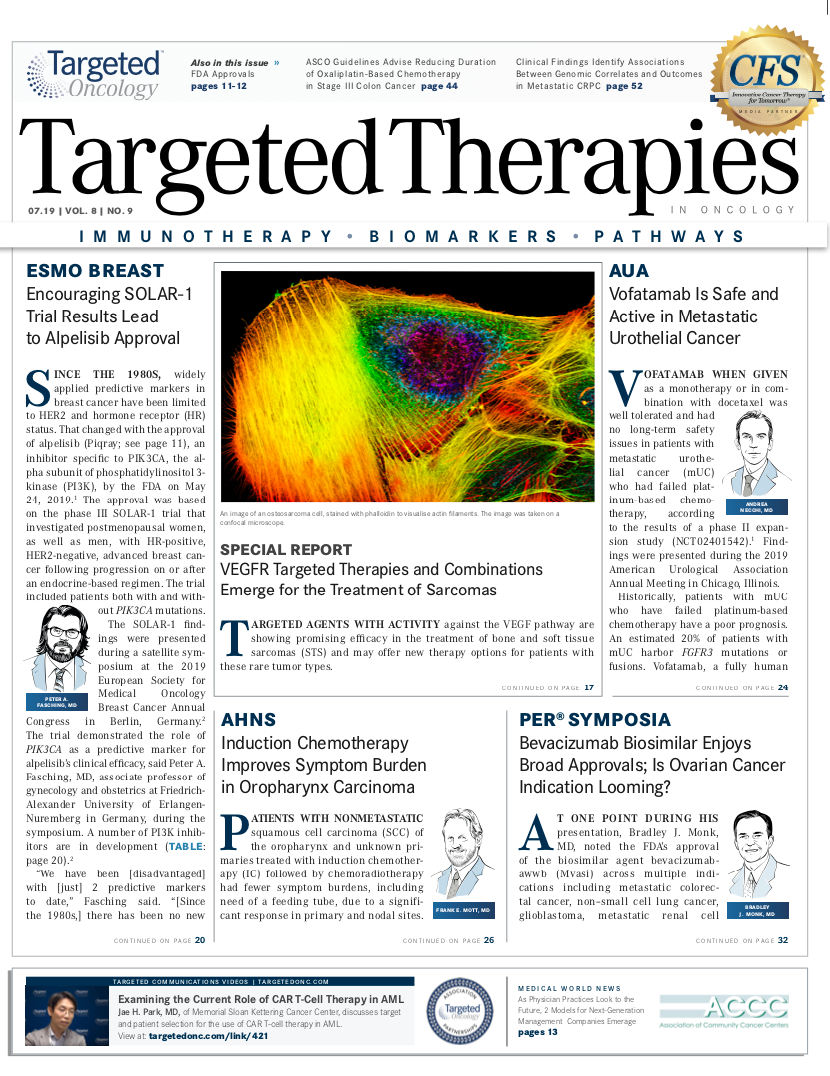Bevacizumab Biosimilar Enjoys Broad Approvals; Is Ovarian Cancer Indication Looming?
Bradley J. Monk, MD, noted the FDA’s approval of the biosimilar agent bevacizumab-awwb across multiple indications including metastatic colorectal cancer, non–small cell lung cancer, glioblastoma, metastatic renal cell carcinoma, and cervical cancer, but he wondered aloud why ovarian cancer was not on the list.
Bradley J. Monk, MD

Bradley J. Monk, MD
At one point during his presentation, Bradley J. Monk, MD, noted the FDA’s approval of the biosimilar agent bevacizumab-awwb (Mvasi) across multiple indications including metastatic colorectal cancer, nonsmall cell lung cancer, glioblastoma, metastatic renal cell carcinoma, and cervical cancer,1but he wondered aloud why ovarian cancer was not on the list.
Monk served as moderator of an ASCO satellite symposium called “Show Me the Data,” hosted by Physicians’ Education Resource®, LLC.2“I was shocked when I reviewed those [subtypes] and ovarian cancer wasn’t included,” Monk, a gynecologic oncologist with Arizona Oncology and professor and director of the Division of Gynecologic Oncology at Creighton University School of Medicine in Phoenix, Arizona, told the audience. He wondered if the ovarian indication was left off “due to a technicality.”
Sanjiv S. Agarwala, MD

Sanjiv S. Agarwala, MD
The National Cancer Institute estimates that 229,875 women were living with ovarian cancer in the United States in 2016,3and the American Cancer Society estimates that there will be 22,530 new cases and 13,980 deaths due to the disease in 2019.4“Although the number of cases is falling, the prevalence is increasing, probably indicating that we’re helping our patients live longer,” Monk said. “But it’s a high unmet medical need.”
A biosimilar is a biologic that is highly similar to an already approved reference product in terms of structure, function, and biological activity.5Other biosimilars of bevacizumab include BCD-021 (Biocad) and bevacizumab-bvzr (Zirabev).
Monk’s focus on the potential treatment of ovarian cancer with a bevacizumab biosimilar agent is warranted given the antiangiogenic properties of bevacizumab (Avastin) and the results of GOG-0218, a 3-arm trial in which 1 arm received bevacizumab maintenance for 1 year after standard frontline chemotherapy.6Burger et al reported a modest but significant improvement in median progression-free survival in the bevacizumab maintenance arm versus the chemotherapy-only arm (14.1 vs 10.3 months; HR, 0.7;P<.001).
In the past year, several bevacizumab combinations have been introduced in the National Comprehensive Cancer Network (NCCN) guidelines for the treatment of patients with ovarian cancer,7as well as 3 PARP inhibitors as maintenance therapyolaparib (Lynparza), rucaparib (Rubraca), and niraparib (Zejula)—ushering in a new era of targeted therapy for ovarian cancer. The results from 3 randomized phase III trials—SOLO2 (olaparib),8NOVA (niraparib),9and ARIEL3 (rucaparib),10served as the basis for PARP inhibitor inclusion in the guidelines’ recommendations.
Monk said the new integrated paradigm involves intravenous carboplatin, paclitaxel, and bevacizumab, followed by bevacizumab maintenance. During the maintenance phase, the patient can undergo germline mutation testing; about one- fourth of patients do not have a germline mutation and can transition to olaparib. Upon progression, patients who did not previously receive olaparib are now eligible for it, along with the other PARP inhibitors, niraparib, and rucaparib.2
It is important to note that a biosimilar product may be approved for an indication even if direct studies of the biosimilar in that indication have not been carried out. The objective of a biosimilar clinical program is to demonstrate that there are no clinically meaningful differences based on the totality of the evidence, not to reestablish benefit. The total evidence gathered for the biosimilar application should support a “demonstration of biosimilarity for at least one of the reference product’s indications,” according to the FDA guidance document.11
Once that has been established, the biosimilar manufacturer can make an argument for approval for other indications that were not directly studiedcalled extrapolation—which is an important component of an abbreviated pathway that improves access and options at a lower cost. In addition to the clinical experience with the reference product, justifying extrapolation requires the biosimilar manufacturer to provide data on factors such as route of administration, function, mechanism of action, and active sites.12
The benefit of extrapolation combines all data and evidence in the biosimilar indication, any safety and efficacy data compiled by the FDA for approved indications for the original product, and any scientific factors for each disease indication.11
Monk emphasized that extrapolation is important because it connects all the data collected from one indication to all indications originally approved for the reference product. In addition, it reduces or eliminates the need for duplicative clinical studies in multiple indications and is a core concept of biosimilarity.
Bringing the discussion back to the community setting, Monk asked the audience members if they would prescribe bevacizumab-awwb for ovarian cancer based on the scientific rationale, rigor of clinical trials, and pharmacovigilance or if they would reject this treatment modality because of the lack of FDA approval for this indication. Referring to the puzzling absence of ovarian cancer from the list of approved indications, Monk asked, “Or are you going to carve out ovarian cancer?”
Copanelist Sanjiv S. Agarwala, MD, chief of medical oncology and hematology at St. Luke’s University Health Network in Philadelphia, addressed the elephant in the room: “This is about reimbursement. Will insurance companies reject coverage because the biosimilar of bevacizumab is not approved in ovarian cancer, even though it’s cheaper [than the reference drug]?”
“So the insurance company is going to say, ‘We don’t want to pay for the cheaper drug,’” added Monk.
Monk concluded his presentation with a call for the adoption of biosimilars in supportive and therapeutic areas.
References
- FDA approves first biosimilar for the treatment of cancer [news release]. Silver Spring, MD: FDA; September 14, 2017. www.fda.gov/news-events/press-announcements/fda-approves-first-biosimilar-treatment-cancer. Accessed June 7, 2019.
- Monk BJ. Show me the data: leveraging the evidence to optimize applications of biosimilars in cancer. Chicago, IL. https://www.gotoper.com/conferences/asco19biosimilars/meetings/asco-biosimilars19/faculty
- Cancer stat facts: ovarian cancer. National Cancer Institute/Surveillance, Epidemiology, and End Results Program website. seer.cancer.gov/statfacts/html/ovary.html. Accessed June 7, 2019.
- Key statistics for ovarian cancer. American Cancer Society website. cancer.org/cancer/ovarian-cancer/about/key-statistics.html. Updated January 8, 2019. Accessed June 7, 2019.
- Guidance document: scientific considerations in demonstrating biosimilarity to a reference product. FDA website. www.fda.gov/regulatory-information/search-fda-guidance-documents/scientific-considerations-demonstrating-biosimilarity-reference-product. Published April 2015. Accessed June 11, 2019
- Burger RA, Brady MF, Bookman MA, et al; Gynecologic Oncology Group. Incorporation of bevacizumab in the primary treatment of ovarian cancer.N Engl J Med. 2011;365(26):2473-2483. doi: 10.1056/NEJMoa1104390.
- Armstrong DK. Highlights of the NCCN 23rd annual conference: new therapies for ovarian cancer.J Natl Compr Canc Netw. 2018;16(5.5):632-635. jnccn.org/abstract/journals/jnccn/16/5S/article-p632.pdf. Accessed June 13, 2019.
- Pujade-Lauraine E, Ledermann JA, Selle F, et al; SOLO2/ENGOT-Ov21 investigators. Olaparib tablets as maintenance therapy in patients with platinum-sensitive, relapsed ovarian cancer and a BRCA1/2 mutation (SOLO2/ENGOT-Ov21): a double-blind, randomised, placebo-controlled, phase 3 trial.Lancet Oncol. 2017;18(9):1274-1284. doi: 10.1016/S1470-2045(17)30469-2.
- Mirza MR, Monk BJ, Herrstedt J, et al; ENGOT-OV16/NOVA Investigators. Niraparib maintenance therapy in platinum-sensitive, recurrent ovarian cancer.N Engl J Med. 2016;375(22):2154-2164. doi: 10.1056/NEJMoa1611310.
- Coleman RL, Oza AM, Lorusso D, et al; ARIEL3 investigators. Rucaparib maintenance treatment for recurrent ovarian carcinoma after response to platinum therapy (ARIEL3): a randomised, double-blind, placebo-controlled phase 3 trial.Lancet. 2017;390(10106):1949-1961. doi: 10.1016/S0140-6736(17)32440-6.
- Biosimilar product regulatory review and approval. FDA website. www.fda.gov/files/drugs/published/Biosimilar-Product-Regulatory-Review-and-Approval.pdf. Accessed June 10, 2019.
- Weise M, Kurki P, Wolff-Holz E, Bielsky MC, Schneider CK. Biosimilars: the science of extrapolation.Blood. 2014 124(22):3191-3196. doi: 10.1182/blood-2014-06-583617.

Biomarker Testing Paves the Way for Better Targeted Therapies in NSCLC
April 16th 2024At a live virtual event, Edward S. Kim, MD, MBA, discussed the evolving landscape of biomarker testing before making treatment decisions for patients with early-stage non–small cell lung cancer (NSCLC).
Read More